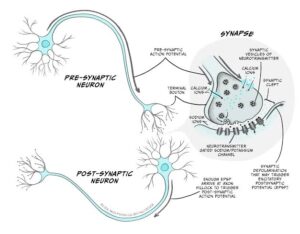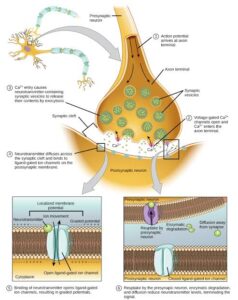Back to: ZOOLOGY 400 Level
Welcome to class!
Hello my ever-curious genius! It’s great to have you here again. Today’s topic is an exciting one because it explains how your brain talks to your body and how messages travel lightning-fast inside you. We’re talking about Action Potentials and Synaptic Transmission — the secret behind every thought, movement, and sensation you experience. Let’s make it simple, real, and very Nigerian, just for you.
Action Potentials And Synaptic Transmission
Every time you blink, smile, dance to Afrobeats, or even remember your Jollof recipe — it’s your nerves at work. These nerves send signals in the form of electrical impulses known as action potentials.
What is an Action Potential?
An action potential is an electrical signal that travels along the membrane of a nerve cell (neuron). It begins when a neuron is stimulated — maybe by touch, heat, or another neuron.

Here’s how it works:
Resting State: When a neuron is not sending a message, it’s at rest. The inside of the cell has more negative ions compared to the outside — this is called the resting membrane potential (about -70 mV).
Depolarisation: When stimulated, sodium (Na⁺) channels open, and Na⁺ rushes into the cell. This makes the inside more positive.
Repolarisation: After the peak, potassium (K⁺) channels open, allowing K⁺ to leave the cell, bringing the charge back down.
Return to Resting State: The sodium-potassium pump restores the original balance by pushing Na⁺ out and pulling K⁺ back in.
This wave of electrical change travels down the neuron — like a spark racing along a wire.
Synaptic Transmission
But how does the signal move from one neuron to another? That’s where synapses come in.
A synapse is the small gap between two neurons.
When the action potential reaches the end of one neuron (axon terminal), it triggers the release of neurotransmitters.
These chemical messengers cross the gap and bind to receptors on the next neuron, triggering a new action potential in that neuron.

Example: Imagine calling your friend using a mobile phone. Your voice (the message) is converted into an electrical signal (action potential), sent through wires, and then converted back to sound on your friend’s phone (synaptic transmission). That’s exactly how your neurons talk to each other.
Summary
- Action potentials are electrical signals used by neurons to send messages.
- They involve a shift in electrical charge across the neuron’s membrane (depolarisation and repolarisation).
- The sodium-potassium pump helps restore the resting potential.
- Synaptic transmission occurs when neurotransmitters carry the signal to the next neuron across a synapse.
- Together, action potentials and synapses allow the nervous system to function properly.
Evaluation
- What is an action potential?
- Describe the role of sodium and potassium ions in nerve signalling.
- What is a synapse?
- How do neurotransmitters help in synaptic transmission?
- Why is the sodium-potassium pump important?
You’ve just unlocked one of the coolest secrets of the human body! You now know how your body talks to itself — and that’s a big win. Keep learning, keep shining, and never stop asking questions. Afrilearn is here with you, cheering you on as you become the best version of yourself. Let’s keep going strong!
